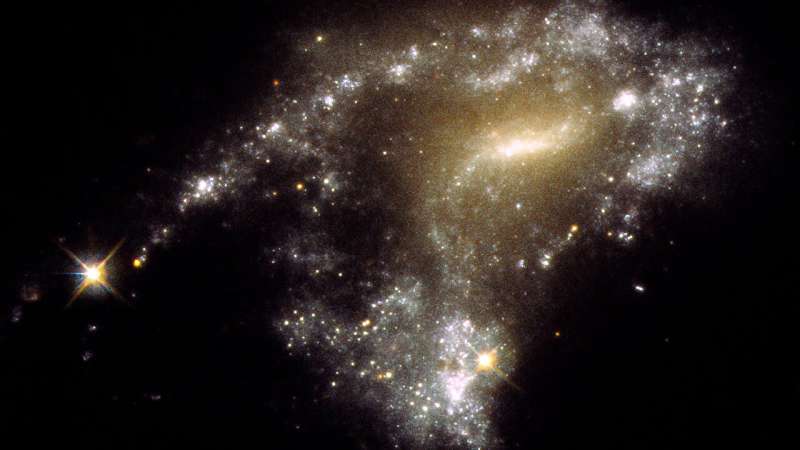This article has been reviewed according to Science X's editorial process and policies. Editors have highlighted the following attributes while ensuring the content's credibility:
fact-checked
peer-reviewed publication
trusted source
proofread
Hubble detects celestial 'string of pearls' star clusters in galaxy collisions

When spectacular cosmic events such as galaxy collisions occur, it sets off a reaction to form new stars, and possibly new planets that otherwise would not have formed. The gravitational pull that forces the collisions between these galaxies creates tidal tails—the long thin region of stars and interstellar gas.
The Hubble Space Telescope's vision is so sharp that it can see clusters of newborn stars strung along these tidal tails. They form when knots of gas gravitationally collapse to create about 1 million newborn stars per cluster.
Specifically, NASA's Hubble Space Telescope has homed in on 12 interacting galaxies that have long, tadpole-like tidal tails of gas, dust and a plethora of stars. Hubble's exquisite sharpness and sensitivity to ultraviolet light have uncovered 425 clusters of newborn stars along these tails, looking like strings of holiday lights.
Each cluster contains as many as 1 million blue, newborn stars.
Clusters in tidal tails have been known about for decades. When galaxies interact, gravitational tidal forces pull out long streamers of gas and dust. Two popular examples are the Antennae and Mice galaxies with their long, narrow, finger-like projections.
In a study recently published in Monthly Notices of the Royal Astronomical Society astronomers used the near-infrared capabilities of NASA's Hubble Space Telescope to study tidal tail clusters and determine their ages and masses, along with properties of the merging galaxies.
Michael Rodruck of Randolph-Macon College is the lead author of this study with co-authors including Arizona State University scientists Sanchayeeta Borthakur and Karen Knierman of the School of Earth and Space Exploration.
A team of astronomers used a combination of new observations and archival data to get ages and masses of tidal tail star clusters. They found that these clusters are very young—only 10 million years old. And they seem to be forming at the same rate along tails stretching for thousands of light-years.
"These observations tell us how stars form and what regulates those processes. This knowledge is critical in understanding how stars in our own galaxy were formed," said Associate Professor Sanchayeeta Borthakur, who is an observational astronomer specializing in extragalactic astronomy at ASU's School of Earth and Space Exploration.
The tails look like they are taking a galaxy's spiral arm and stretching it out into space. The exterior part of the arm gets pulled like taffy from the gravitational tug-of-war between a pair of interacting galaxies.
Before the mergers, the galaxies were rich in dusty clouds of molecular hydrogen that simply may have remained inert. But the clouds got jostled and bumped into each other during the encounters. This compressed the hydrogen to the point where it precipitated a firestorm of star birth.
The fate of these strung-out star clusters is uncertain. They may stay gravitationally intact and evolve into globular star clusters—like those that orbit outside the plane of our Milky Way galaxy. Or they may disperse to form a halo of stars around their host galaxy, or get cast off to become wandering intergalactic stars.
"It's so exciting to present the culmination of over two decades of work on star clusters in tidal tails using data from different eras of Hubble together with that from other telescopes," Assistant Teaching Professor Karen Knierman said. "I started working on this project as an undergraduate at Penn State in 1999, and some of that same data and results are used here. We got additional data from a Hubble program I was (principal investigator) for when I came to ASU in 2007."
This string-of-pearls star formation may have been more common in the early universe when galaxies collided with each other more frequently. These nearby galaxies observed by Hubble are a proxy for what happened long ago, and therefore allow us to look into the distant past.
"It's a surprise to see lots of the young objects in the tails. It tells us a lot about cluster formation efficiency," Rodruck said. "With tidal tails, you will build up new generations of stars that otherwise might not have existed."
More information: Michael Rodruck et al, Star clusters in tidal debris, Monthly Notices of the Royal Astronomical Society (2023). DOI: 10.1093/mnras/stad2886 , academic.oup.com/mnras/article/526/2/2341/7286662
Journal information: Monthly Notices of the Royal Astronomical Society
Provided by Arizona State University




















